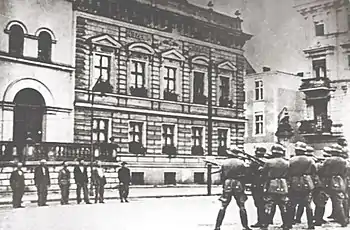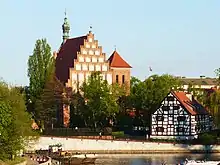Timeline of Bydgoszcz
Prior to 20th century
- 1037–1053 – Fortified stronghold built.
- 1346 – Bydgoszcz granted city rights by King Casimir III the Great.
- 1520 – Sejm of the Kingdom of Poland held in Bydgoszcz.[1]
- 1557 – Bernardine Church completed.
- 1594 – Mint established.
- 1619 – Jesuit school, present day High School No. 1, founded.
- 1645 – Poor Clares' Church completed.
- 1657 – Treaty of Bydgoszcz signed.
- 1764 – Bydgoszcz became one of three seats of the Crown Tribunal for the Greater Poland Province after the Convocation Sejm of 1764.
- 1767 – Józef Wybicki, author of the lyrics of the national anthem of Poland, works at the Crown Tribunal in Bydgoszcz.[2]
- 1772 – Bydgoszcz annexed by Prussia in the First Partition of Poland.
- 1794 – City recaptured by Poles led by General Jan Henryk Dąbrowski during the Kościuszko Uprising.[2]
- 1807 – Bydgoszcz becomes part of the Duchy of Warsaw
- 1815 – Bydgoszcz re-annexed by Prussia.
- 1864 – National Bank of Poland building completed.
- 1871 – City becomes part of the German Empire.
- 1872 – Special educational centre for blind children founded.
- 1899 – Main Post Office completed.
20th century
1901–1939
- 1906 – Municipal Market Hall and Copernicanum building completed.
- 1908 – Population: 57,696.[3]
- 1919 – Bydgoszcz restored to Poland after the country regained independence.
- 1920 – Polonia Bydgoszcz football club (future multi-sports club) founded.
- 1923 – Regional Museum in Bydgoszcz founded.
- 1929 – City hosts the 1929 European Rowing Championships.
- 1930 – Botanic Garden of Casimir the Great University founded as the Municipal Botanic Garden.
World War II (1939–1945)

German execution of Polish hostages at the Market Square in 1939
- 1939
- September: City is occupied by Nazi Germany.
- 3 September: German diversion, resulting in Polish-German skirmishes, which were referred to as the Bloody Sunday by propaganda of Nazi Germany to serve as an excuse for planned German massacres of Polish residents.
- 3–10 September: Germans massacred 192 Poles in the city.[4]
- September: Einsatzgruppe IV, Einsatzkommando 16 and SS-Totenkopf-Standarte "Brandenburg" Nazi paramilitary death squads entered the city.[5]
- 10 September: Germans carried out mass searches of houses throughout the city.[4]
- 24 September: Appointed German Kreisleiter called local Polish city officials to a supposed formal meeting in the city hall, from where they were taken to a nearby forest and exterminated.[6] He also ordered the execution of their family members to "avoid creating martyrs".[6]
- September: Nazi prison and forced labour camp established by the Germans at Wały Jagiellońskie Street.[7]
- 22, 29 September: Massacres of 250 Polish activists previously imprisoned in a local Selbstschutz prison during the Intelligenzaktion.[4]
- 30 September: Over 3,000 Poles imprisoned by the Germans in the city as of 30 September.[8]
- Early October: Further mass arrests of over 2,000 Poles.[8]
- 18–20 October: Further mass arrests of nearly 1,500 Poles, incl. activists and teachers, carried out by the German police, Einsatzkommando 16 and Selbstschutz.[8]
- October–November: Large massacres of Poles and Jews carried out by the Germans in the Valley of Death.
- 1 November: City unilaterally annexed by Germany.[9]
- 11 November: Further mass arrests of 3,800 Poles carried out by the German police and Selbstschutz.[10]
- 11 November: Public execution of pre-war Polish mayor Leon Barciszewski by the Germans.[11]
- 17 November: Commander of the local SD-EK unit declared there was no more Polish intelligentsia capable of resistance in the city.[11]
- November: Einsatzgruppen-operated penal camp established in the Jachcice district.[12]
- Massacres of over 1,400 Poles from Bydgoszcz, incl. teachers, activists, priests, old people, boy and girl scouts, gymnasium students, and children as young as 12, in the nearby village of Tryszczyn.[13][14]
- 1940 – January: Poles from Bydgoszcz among the victims of a massacre perpetrated by the Selbstschutz in Jastrzębie.[15]
- 1941
- 4 February: First mass transport of 524 Poles sent from Bydgoszcz to the Potulice concentration camp.[16]
- May: Forced labour camp established by the Germans in the Smukała Dolna district.[17]
- 1943
- March: Rescue of some kidnapped Polish children from the Zamość region by local Poles.[18]
- The local Polish resistance movement sheltered British prisoners of war who escaped from the German Stalag XX-A POW camp, and facilitated their escapes to neutral Sweden.[19]
- 1944 – Bromberg-Ost subcamp of the Stutthof concentration camp established by the Germans.
- 1945 – End of German occupation, Bydgoszcz restored to Poland.
1945–2000
- 1949 – Polish Theatre in Bydgoszcz completed.
- 1951 – Bydgoszcz University of Science and Technology founded.
- 1955 – Polonia Bydgoszcz wins its first Team Speedway Polish Championship.
- 1969 – Kazimierz Wielki University in Bydgoszcz founded.
- 1978 – Andrzej Szwalbe Collection of Historical Pianos founded by Andrzej Szwalbe.[20]
- 1981 – Bydgoszcz events.
- 1984 – Nicolaus Copernicus University Ludwik Rydygier Collegium Medicum in Bydgoszcz founded.
- 1993 – Pałac Bydgoszcz wins its first Polish women's volleyball championship.
- 2000 – Andrzej Szwalbe Collection of Historical Pianos relocated from Bydgoszcz to the Palaces and park ensemble in Ostromecko.
21st century

Bydgoszcz Old Town in 2019
- 2004
- 24 February: Roman Catholic Diocese of Bydgoszcz established.
- 31 March: NATO Joint Force Training Centre founded.
- 2005 – Marian Rejewski monument unveiled on the 100th anniversary of his birth.[21]
- 2006 – Opera Nova Bydgoszcz completed.
- 2007 – Andrzej Szwalbe monument unveiled.[22]
- 2009
- September: City co-hosts the EuroBasket 2009.
- September–October: City co-hosts the 2009 Women's European Volleyball Championship.
- 2010 – City hosts the 2010 IAAF World Cross Country Championships.
- 2011
- June–July: City co-hosts the EuroBasket Women 2011.
- 7 July: Exploseum founded.
- 2013 – City hosts the 2013 IAAF World Cross Country Championships.
- 2017 – City co-hosts the 2017 UEFA European Under-21 Championship.
- 2019
- May–June: City co-hosts the 2019 FIFA U-20 World Cup.
- 24 October: Monument to the Wisła Detachment of the Polish Navy, which fought in the area against the German invasion of 1939, unveiled.[23]
See also
References
- Konopczyński, Władysław (1948). Chronologia sejmów polskich 1493–1793 (in Polish). Kraków: Polska Akademia Umiejętności. p. 135.
- Krzysztof Drozdowski. "Rocznica śmierci Józefa Wybickiego. Razem z generałem Dąbrowskim wyzwalał Bydgoszcz". Tygodnik Bydgoski (in Polish). Retrieved 10 July 2022.
- "German Empire: Area and Population: Principal Towns". Statesman's Year-Book. London: Macmillan and Co. 1913. hdl:2027/njp.32101072368374.
- Wardzyńska 2009, p. 110.
- Wardzyńska 2009, pp. 55, 61–62.
- Wardzyńska 2009, p. 102.
- "NS-Gefängnis als Straflager Bromberg, Große Bergstraße". Bundesarchiv.de (in German). Retrieved 10 July 2022.
- Wardzyńska 2009, p. 157.
- Wardzyńska 2009, p. 144.
- Wardzyńska 2009, pp. 157–158.
- Wardzyńska 2009, p. 160.
- "Einsatzgruppen-Straflager Bromberg-Jagdschütz". Bundesarchiv.de (in German). Retrieved 10 July 2022.
- Wardzyńska 2009, pp. 157–159.
- Drywa, Danuta (2020). "Germanizacja dzieci i młodzieży polskiej na Pomorzu Gdańskim z uwzględnieniem roli obozu koncentracyjnego Stutthof". In Kostkiewicz, Janina (ed.). Zbrodnia bez kary... Eksterminacja i cierpienie polskich dzieci pod okupacją niemiecką (1939–1945) (in Polish). Kraków: Uniwersytet Jagielloński, Biblioteka Jagiellońska. p. 180.
- Wardzyńska 2009, pp. 182.
- Molesztak, Aldona (2020). "Doświadczenia obozowe dzieci w niemieckim obozie przesiedleńczym i pracy w Potulicach i Smukale - wspomnienia więźniarek". In Kostkiewicz, Janina (ed.). Zbrodnia bez kary... Eksterminacja i cierpienie polskich dzieci pod okupacją niemiecką (1939–1945) (in Polish). Kraków: Uniwersytet Jagielloński, Biblioteka Jagiellońska. p. 193.
- "Arbeitserziehungslager Mühlthal". Bundesarchiv.de (in German). Retrieved 10 July 2022.
- Kozaczyńska, Beata (2020). "Gdy zabrakło łez... Tragizm losu polskich dzieci wysiedlonych z Zamojszczyzny (1942-1943)". In Kostkiewicz, Janina (ed.). Zbrodnia bez kary... Eksterminacja i cierpienie polskich dzieci pod okupacją niemiecką (1939–1945) (in Polish). Kraków: Uniwersytet Jagielloński, Biblioteka Jagiellońska. p. 123.
- Chrzanowski, Bogdan. "Organizacja sieci przerzutów drogą morską z Polski do Szwecji w latach okupacji hitlerowskiej (1939–1945)". Stutthof. Zeszyty Muzeum (in Polish). 5: 31–32. ISSN 0137-5377.
- Vogel, Beniamin (2016). Kolekcja Zabytkowych Fortepianów im. Andrzeja Szwalbego w Ostromecku (in Polish and English). Bydgoszcz: Miejskie Centrum Kultury w Bydgoszczy. p. 7. ISBN 978-83-64942-08-2.
- "Odsłonięto pomnik Mariana Rejewskiego". Nauka w Polsce (in Polish). Retrieved 10 July 2022.
- "Pomnik Andrzeja Szwalbego w Bydgoszczy". Interia (in Polish). Retrieved 10 July 2022.
- "Odsłonięcie i poświęcenie pomnika bohaterskich marynarzy na śluzie Brdyujście w Bydgoszczy". Regionalny Zarząd Gospodarki Wodnej w Bydgoszczy (in Polish). Retrieved 10 July 2022.
Bibliography
- Wardzyńska, Maria (2009). Był rok 1939. Operacja niemieckiej policji bezpieczeństwa w Polsce. Intelligenzaktion (in Polish). Warszawa: IPN.
External links
- http://www.bydgoszcz.pl/ (Polish)
- http://www.visitbydgoszcz.pl/ (Polish, English)
- Municipal website (in English)
- Wirtualna Bydgoszcz – informator bydgoski (in Polish)
- Bydgoszcz news (in Polish)
- Canal Bydgoski at the Wayback Machine (archived December 28, 2007) (in Polish)
- Evangelical – Augsburg (Lutheran) Parish in Bydgoszcz (in English)
- Foto Galeria Bydgoska – foto.bydgoszcz.pl (in Polish)
This article is issued from Wikipedia. The text is licensed under Creative Commons - Attribution - Sharealike. Additional terms may apply for the media files.
